The Founders
The Founders
PORTRAITS OF THE SaCO MASTER INSTRUCTORS

Frank Pelny
SaCO
* president of SaCO* IVth master degree
* Master-Instructor
KARATE
* 7th DAN Shôtôkan-Karate-Dô (WKF)* 3rd DAN Shôtôkan-Karate-Dô (JKA)
* Trainer-A licence Karate of GOSA
* Examiner-A-licence German Karate Federation
KOBUDÔ
* 6th DAN Ryûkyû Kobudô Tesshinkan* Shihan Menkyo
* Renshi
* Shibu-Chô of Ryûkyû Kobudô Tesshinkan Kyô Kai - Europe
others:
* 1st master degree ESDO* ESDO-Instructor
* 2nd KYÛ JUDÔ
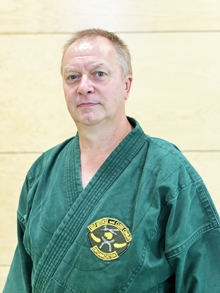
Egbert Gudlat
SaCO
* Vize president of SaCO* IVth master degree
* Master-Instructor
KARATE
* 4th DAN Karate (WKF)* Trainer-B licence Karate of GOSA
KOBUDÔ
* 2nd DAN Hanbo-Jitsuothers:
* 1st master degree ESDO* ESDO-Instructor
Military Close Combat
Military Close Combat
Development and Test Content
Development of the military sport
 Military close-combat is the general label for unarmed duel techniques under military operation conditions whose aim is to insure that some soldiers live through the duel and at the same time kill or at least completely disarm the opponent as fast as possible.
Military close-combat is the general label for unarmed duel techniques under military operation conditions whose aim is to insure that some soldiers live through the duel and at the same time kill or at least completely disarm the opponent as fast as possible.
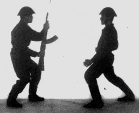 In the National People's Army (NPA) of the former German Democratic Republic (GDR) the military close combat was also a trademark for a military sport art. Members of the army trained in the close-combat system during their training and also in training groups during their leisure time. The military sport art Military Close-combat first officially emerged in 1986. It was however the result of decade-long developments.
In the National People's Army (NPA) of the former German Democratic Republic (GDR) the military close combat was also a trademark for a military sport art. Members of the army trained in the close-combat system during their training and also in training groups during their leisure time. The military sport art Military Close-combat first officially emerged in 1986. It was however the result of decade-long developments.
 Before the founding of the NPA in 1956, already in existence, apart from the Police (PP-People's Police) armed units, was the KVP (Kasernierte People's Police). Self-defence was instructed in both authorities like was in the Course book on Judo Self defence, verified in March 1952 by the publishing house for Police Special Literature, Berlin Wilhelmsruh. This self-defence was still characterised by the JIU-JITSU techniques of the pre-war times. It ended the appropriate police task of bringing attackers under control with the hold-down technique or the transport technique.
Before the founding of the NPA in 1956, already in existence, apart from the Police (PP-People's Police) armed units, was the KVP (Kasernierte People's Police). Self-defence was instructed in both authorities like was in the Course book on Judo Self defence, verified in March 1952 by the publishing house for Police Special Literature, Berlin Wilhelmsruh. This self-defence was still characterised by the JIU-JITSU techniques of the pre-war times. It ended the appropriate police task of bringing attackers under control with the hold-down technique or the transport technique. With the founding of the National People's Army in the former GDR, the close-combat system was taken up in the training programme for the military body-efficiency (MBE) / physical training (P.T). The training was regulated through service regulations (SR), complete instructions (I), and programme and standard catalogue instructions. The demand on the military body-efficiency (MBE) was determined by the SR 010/0/002.
With the founding of the National People's Army in the former GDR, the close-combat system was taken up in the training programme for the military body-efficiency (MBE) / physical training (P.T). The training was regulated through service regulations (SR), complete instructions (I), and programme and standard catalogue instructions. The demand on the military body-efficiency (MBE) was determined by the SR 010/0/002.
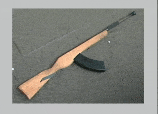 Every member of the army graduated after at least 2 hours of close combat with fence machine-pistol (MPi). The Fence MPi was in size and mass an exact imitation of the standard firearm weapon Machine-Pistol Automat Kalaschnikow 1947 (MPi AK-47) and was specially used in the physical training.
Every member of the army graduated after at least 2 hours of close combat with fence machine-pistol (MPi). The Fence MPi was in size and mass an exact imitation of the standard firearm weapon Machine-Pistol Automat Kalaschnikow 1947 (MPi AK-47) and was specially used in the physical training.
![]() Soldiers for reconnaissance and long-range reconnaissance, paratroopers and fight swimmers (seals) had more hours of training for the close combat at their disposal after every service course. They also trained in self-defence and unarmed defence from attacks with weapons.
Soldiers for reconnaissance and long-range reconnaissance, paratroopers and fight swimmers (seals) had more hours of training for the close combat at their disposal after every service course. They also trained in self-defence and unarmed defence from attacks with weapons.
 The used techniques from 1956 to 1986 of the old JIU-JITSU to the military close combat changed at the same time. The new system had to be easy to learn, effective, systematic and also have useable equipment in the combat field.
The used techniques from 1956 to 1986 of the old JIU-JITSU to the military close combat changed at the same time. The new system had to be easy to learn, effective, systematic and also have useable equipment in the combat field.
As a basis, people relied on the karate techniques. As a base, the NPA reproduced and supplied books from the West German Karate pioneer, Albrecht Pflüger, who through dark channels procured (e.g. the author also released his first book). In addition people used complex movements from the close combat programme of the Soviet Military Forces (see complex test course). This Karate foundation (punches, blocks, kicks) was combined with selected Judo elements (fall-school, levers, chokes and throws), elements of the shotgun, knife and spade fights and the self-defence. All these were united into one system.
Some officers deserve credit for their long years of hard work that resulted in a military sport:
- Lieutenant Colonel Michael Stölzner, chairman of the commission of military close combat for the management of the sport organisation of the land forces and defender of the close combat education.
- Lieutenant Colonel Hans-Jörg Tännert, paratrooper officer, instructor at the Officer's High School (OHS) for the land forces, training leader of a close combat trainings group at the OHS Löbau.
- Major Dr. Dietmar Kircheis, sport instructor at the Officer's High School for the land forces, JUDO-DAN-Holder, Karate training leader of the close combat training group at the OHS Löbau, consultant for the close combat educational films of the NPA army film studios in Berlin Babelsberg.
- Captain Andreas Förster, sport officer in the paratrooper battalion-40
- Captain Holger Arnold, sport officer in the air-storm regiment-40
- Captain Frank Pelny, troop and border reconnaissance officer, author of the "Documentation about the methodical training in Gjogsul" and "Handbook for training leaders in military close combat", contributed to the educational film "Close Combat: How train?"

 The techniques and test programme of the military close combat were in 1986 in the "Instruction for exercise, training and contest in the military sport art military close combat", confirmed and published at the military close combat commission of the sport organisation of the land forces. Tgb.-Nr W/48/1986.
The techniques and test programme of the military close combat were in 1986 in the "Instruction for exercise, training and contest in the military sport art military close combat", confirmed and published at the military close combat commission of the sport organisation of the land forces. Tgb.-Nr W/48/1986.
Test programme
The test programme has four graduation levels:
Yellow-, Orange-, Green- and Blue belt. In plan although never realised was the expansion to a brown belt and a black belt.
Frank Pelny was the first person in the GDR to successfully pass the test to the highest level at the time, the blue belt (2nd graduate level). This was on the 21.10.1988 from a commission in the air-storm regiment-40 in LEHNIN.
Every graduate level is tested in five areas:
- Athletic test Duration 3 minutes without a break.
1 minute hanging from the target wall with the feet (5 points per piece)
1 minute press ups on the fist knuckles. The feet should be on the third
lowest bar of the wall bars and the chest must touch the ground during
the press-ups. (3 points per piece)
1 minute skipping (from 50. 1 point for each piece) - Demonstration ability.
- Attach effectiveness.
- Defence ability.
- Fighting behaviour.
A sporting contest system for the military close combat was created to motivate and improve the fighting behaviour. At the same time there was a contest of three competitions:
- The athletic competition (corresponds to the athletic test)
- The technique competition (single demonstration of a complex test)
- The fight (free fight according to every qualification: 2x1 or 2x2 minutes determined the security equipment and protection vests until the mouth and deep protection).
The close combat vest (CCV-85) was developed especially for the contest and training with the attack technique. The vest has a complete torso protection with neck and additional forearm cuffs. The vest has about 5cm of thick padding and enables the execution of techniques with complete energy.
To improve the existing fight system, the courses on GJOGSUL in the air-storm regiment-40 in LEHNIN, POTSDAM were in 1988 implemented, a secret and fighter-rehearsed close combat system of the North Korean People's Army.
(more information under "History - GJOGSUL")
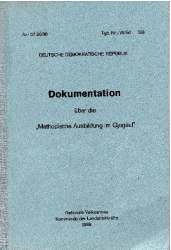
In analysis, the military close combat system with suitable elements from the fighter-rehearsed GJOGSUL was modified through these course experiences. As a result, the highly effective close combat system emerged and was spread everywhere in the National People's Army and to border troops.
The technical basis of GJOGSUL was through Captain Frank Pelny, a course participant by whom "Documentation about the methodical training in Gjogsul" (Ag 117 XLIII-03-056-89, Tgb.-Nr.: W/50/89, Az.: 57 20 08), detachment of the land forces of the NPA in 1989, described in text and graphically represented.
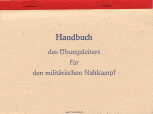
In the same year, the "Handbook for training leaders in military close combat" (Ag 117 VIII-03/253-89), 1989, committee of the sport organisation of the border troops of the GDR, also from Captain Frank Pelny was released. This pamphlet became an important functioning base for many instructors.
In June 1989, karate was also official in the GDR and made legal among the military forces. Through the political change in November 1989, the practical conversion of this possibility was no longer effective.
The political change and the reunion of the two German states saw the end of the military close combat system, although at this time, a new test programme was in preparation. This programme was technically more extensive and the experiences from the GJOGSUL course and the different currents with in the MCC commission were considered.
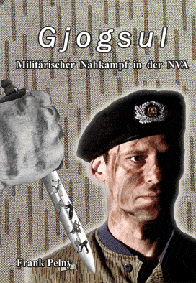
A presentation of the military close combat system including gjogsul successfully resulted in the book "Gjogsul - military close combat in the NPA" by Frank Pelny, released in 2005, published by Books on Demand Norderstedt / Germany (ISBN 3-8334-2228-9; 352 Pages; ca. 550 Photos).
(more informations under "SaCO-articles - SaCO-Books")
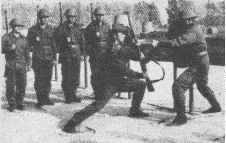
It must be noted that an training theme under the theme military close combat was produced in the NPA film studio in Berlin-Biesdorf, Frankenholzer-Weg. The film was called "Close Combat: How train?" (Requisitions -Nr. AII/156, 28min., 1983) and "Close Combat for specialists" (28min., 1987). Also in existence was a film on the training of close combat from the Soviet Airborne troops. Still in preparation was an training film on GJOGSUL.
The military close combat was a development of the land forces of the NPA. The air forces / air defence, the people's navy, especially the fight swimmers (seals) as well as the border troops with time took over part or the complete system of the military forces.

The Interior Ministry and the Ministry for Security of the GDR developed a characterised system based on their respective tasks. The system was described in the book "Duel training", (Interior Ministry, 1973, AG 106/290/73)
There were only three graduation levels in this system:
Service belt duel
- Level III (white-yellow belt),
- Level II (white-red belt),
- Level I (white-green belt).
Self-defence as well as transport and determination techniques were exclusively tested.
SaCO – The Success Story
THE SUCCESS STORY of SaCO
The official foundation of SaCO was laid on 01.01.1995 with the aim of:
- Creating an organisation structure that would, through the distribution of a systematised SaCO self-defence, make possible the education of instructors and acknowledge a gradual system.
- Preserving the authentic military close combat fighting system of the NPA (National People's Army) of the former GDR (German Democratic Republic) because there is no comparable existing system in the Federal Armed Forces of the Federal Republic of Germany.
1989 - 1993

After the political change in the former GDR in 1989 and the reunion of the two German states in 1990, close combat fighting lost meaning. Many outstanding experts in East Germany used their ability and established sport fight clubs or led self-defence courses for the people.
In addition, Frank Pelny conducted trainings with work securities, criminal police, military police and hand-to-hand combat specialists of the Federal Armed Forces. With this experience, he analysed and managed to come up with a realistic system of self-defence, which he integrated, into the existing close combat system.

The systematised self-defence is represented and described by Frank Pelny in his book
"FAKT - line handbook of self-defence for security in private industry", self-published through Mr. Ernst Friday from Wilhelmshaven in 1992.
In 1993, the first apprenticeship video, in which systematised self-defence at the time can be seen, was generated.
A temporary total representation of the close combat military system including self-defence, resulted in the book "GJOGSUL - Duel in case of emergency", which in was in 1996 released by Kabinett-Verlag / Switzerland (ISBN 906572-02-1; with about 198 pages and 400 photos)
1994 - today
Together with Egbert Guldat, a long time training comrade, Frank Pelny expanded the system. For example, the practice sequence with partners was developed, the famous weapon drills with which the acquisition and automation of the weapon technique were revised. Complex exercises for the different weapons were also created. The systematic self-defence was also permanently perfected. The graduation system was also repeatedly revised and finally perfected. The result was the SaCO emblem.
The resulting system was called SaCO - SELF-DEFENSE and CLOSE COMBAT ORGANIZATION. It united in appropriate form the effective systematised self-defence and rehearsed military closed combat fights. Through this, it is possible to teach a system and nevertheless uncover different specialized substitute areas.


On the 23.08.1995, SaCO was recognised as a trademark through the German patent office in Munich.
SaCO is since 27.02.2000 a group member in the Karate association of the federal state Thuringia.
SaCO is also recognised by the paratrooper-association east. As the organisation that preserves the authentic military close combat fighting.
In the mean time, there are SaCO training groups in many of the german states. Even the American policemen, to who this system was introduced, reacted enthusiastically. SaCO intends to spread to America and the rest of the world in the coming years.
SaCO - Organisation Structure
SaCO consists of:
- the SaCO-presidency with MASTER-INSTRUCTORS who organise the SaCO business locations.
- the SaCO - training groups and schools
SaCO - Orders
SaCO as a working foundation has 5 orders:
- Organisation order,
- Study order,
- Test and licence order,
- Fees order,
- Fee orders for examiners,
English was selected as the concept language so that with the expansion of SaCO outside Germany, a language spoken and understood by the majority would there. During training, commands and explanations from the trainers are given in respective mother tongues.
SaCO - Education Programs

- 5 student degrees in 10 levels.
Yellow, orange, green, blue and brown belts. Every degree is tested at two levels:- B-Test (coloured belt)
- A-Test (coloured belt with red stripes)
- 4 master degrees
SaCO - Education Contents
 The gradual levels are tested in five areas:
The gradual levels are tested in five areas:
- Form
B: complex tests without weapons;
A: complex training with weapons, weapon-drills; - Technical effectiveness
B: techniques with the paws;
A: lever / nerve pressure points, throwing techniques; - Command techniques
A: fall school, defences on ground, transport techniques, special situations. - Theory
B: legal foundations, psychological foundations, vulnerable body positions, rules of conduct; - Defence ability
B: hand-to-hand combat drill;
A: weapon fight circle;
B+A: self-defence fight circle.
GJOGSUL
Dschudsche GJOGSUL / GJOK-SUL
The close combat system of the People's Army of the People's Democratic Republic of Korea (PDRK)
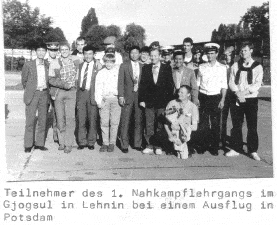 The Soviet army with its SAMBO-System that unites the different fighter-experiences and the experience of the war in Afghanistan, the Soviet military adviser in the exchange programme and the border fights at the Soviet-China border as well as their experience from the Vietnamese People's Army with their traditional VIET-VO-DAO system and their experience from the war against USA, controlled and led to a highly developed fight system. Unfortunately, the brotherhood weapons in this area were on leadership levels insufficient, none of the involved parties shared their experience and knowledge with each other.
The Soviet army with its SAMBO-System that unites the different fighter-experiences and the experience of the war in Afghanistan, the Soviet military adviser in the exchange programme and the border fights at the Soviet-China border as well as their experience from the Vietnamese People's Army with their traditional VIET-VO-DAO system and their experience from the war against USA, controlled and led to a highly developed fight system. Unfortunately, the brotherhood weapons in this area were on leadership levels insufficient, none of the involved parties shared their experience and knowledge with each other.Through the personal friendship of the head of the land forces of the National People's Army (NPA) of the former GDR, Colonel General Horst Stechbarth, with the head of state of the People's Democratic Republic of Korea (PDRK), Kim II Sung (15.04.1912-08.07.1998), an instructor team from North Korea was in 1988 brought to the GDR to execute a course on the north Korean close combat system Gjogsul.
There were altogether between 6th June and 5th August 1988 three consecutive three-week courses in the air-storm regiment-40 in LEHNIN in POTSDAM. The participating qualified soldiers from different fields of the GDR like paratroopers, soldiers for reconnaissance and long-range reconnaissance, fight swimmers (seals), border troops and military counterintelligence were specially chosen and listed by name in command 38/88 of the Minister for National Defence in the GDR.
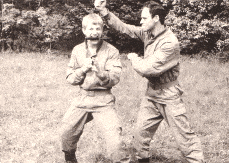
The North Korean instructor team consisted of 4 members.
2 instructors who were paratrooper officers and taught GJOGSUL at the North Korean Military Academy "Kim II Sung":
- Delegation leader Captain Rim Mjong Snob, 6 degrees in Gjogsul,
34 years old, married with 2 children, trained in Gjogsul for 14 years. - First Lieutenant Tschä Ho II, 5 degrees in Gjogsul,
31 years old, married with 1 child, trained in Gjogsul for 10 years..
In addition 2 interpreters:
- Major Bak Jong Kjun
- Lieutenant So Dzin, who studied German Language and Literature in Leipzig.
The basics of the North Korean close combat were offered in these courses. These basics proved to be of practical use in the battle against the Japanese and later the Americans. The Gjogsul is based on the bases of the old Korean fight systems.
The programme for the first three-week course in Gjogsul
| 1st Week: | ||
| Monday | Arrival Inauguration of course |
|
| Thuesday | 08.00 - 09.30 09.30 - 10.00 10.00 - 11.30 13.00 - 14.00 14.30 - 16.00 19.00 - 21.00 |
Review of skills Break Warm up and basic technique training Examination of training base Training in basic techniques Volleyball tournament |
| Wednesday | 08.00 - 09.30 10.00 - 11.30 13.00 - 14.00 14.30 - 16.00 19.00 - 21.30 |
Learning the kicks Learning the kicks Lecture on Gjogsul Repetition and technique training Visit restaurant |
| Thursday | 08.00 - 09.30 10.00 - 11.30 13.00 - 14.00 14.30 - 16.00 19.00 - 21.30 |
Learning complex exercises-1 (HYONG DONG ZAK IL) Learning complex exercises-1 (HYONG DONG ZAK IL) Lecture on the work of the sport organisation of land forces Practicing complex exercises-1 Swimming centre or Sauna |
| Friday | 08.00 - 09.30 10.00 - 11.30 13.00 - 14.00 14.30 - 16.00 |
Learning complex exercises-2 (HYONG DONG ZAK I) Learning complex exercises-2 (HYONG DONG ZAK I) Film "Close Combat: How train?" Practicing complex exercises-2 |
| Saturday | 08.00 - 09.30 10.00 - 11.30 13.00 - 18.30 |
Repetition Repetition Excursion: Potsdam - Cecilienhof and Army museum |
| Sunday | 08.00 - 09.30 10.00 - 11.30 15.00 - 19.00 |
Supervision of complex exercises 1 and 2 Learning complex attack combinations Excursion on the lakes about Potsdam |
| 2nd Week | ||
| Monday | 08.00 - 09.30 10.00 - 11.30 13.00 - 14.00 14.30 - 16.00 18.00 - 21.00 |
Learning from parry's with MPi Learning from parry's with MPi Personal studies 6. conference ZK of SED Practice from parry's with MPi on land Sport evening |
| Thuesday | 08.00 - 09.30 09.30 - 10.00 10.00 - 11.30 13.00 - 14.00 14.30 - 16.00 19.00 - 21.30 |
Learning from 10 pistol defences Learning from 10 pistol defences Political information Visit to the ATZ-40 (training centre) Visit restaurants |
| Wednesday | 08.00 - 09.30 10.00 - 11.30 13.00 - 14.00 14.30 - 16.00 19.00 - 21.30 |
Learning complex knife exercises Learning from 10 knife defences Film "Close combat for specialists" Practicing knife defences Swimming centre or sauna |
| Thursday | 08.00 - 09.30 10.00 - 11.30 13.00 - 14.00 14.30 - 16.00 19.00 - 21.00 |
Leaning to throw knives Leaning to throw knives Lecture on Gjogsul general repetition Exchanging experiences on the development of the military close combat |
| Friday | 08.00 - 09.30 10.00 - 11.30 13.00 - 14.00 14.30 - 16.00 18.30 - 20.00 |
Defence against 3-5 attackers without weapons Defence against 3-5 attackers without weapons Lecture on the Olympic movement Defence against 8 attackers with weapons Cinema |
| Saturday | 08.00 - 09.30 10.00 - 11.30 Afternoon free |
Defence against 8 attackers with weapons Defence against 8 attackers with weapons |
| Sunday | 08.00 - 09.30
10.00 - 11.30 |
Learning defence attack combinations (complex attack combinations with a partner) Learning defence attack combinations |
| 3rd Week | ||
| Monday | 08.00 - 09.30 10.00 - 11.30 13.00 - 14.00 14.30 - 16.00 18.00 - 20.00 |
Testing exercises with boards and bricks Hard blow training Lecture on Gjogsul-competition Practical demonstration on Gjogsul-competition pistol shooting competition |
| Thuesday | 08.00 - 09.30 09.30 - 10.00 10.00 - 11.30 13.00 - 14.00 14.30 - 16.00 |
Repetition MPi defences and pistol defences Repetition MPi defences and pistol defences Film "The physical training by paratroopers" MPi defences and pistol defences test. |
| Wednesday | 08.00 - 09.30 10.00 - 11.30 13.00 - 14.00 14.30 - 16.00 19.00 - 21.00 |
Repetition of knife defences and combined attack defences Repetition of knife defences and combined attack defences Political information Knife defences and combined attack defences test Swimming centre |
| Thursday | 08.00 - 16.00 19.00 - 22.00 |
Preparation for the final presentation Closing party with cones |
| Friday | 08.00 - 09.00 09.00 - 10.00 10.00 - 11.00 departure |
Preparation for the presentation Presentation for the military attaché Evaluation course and course results. |
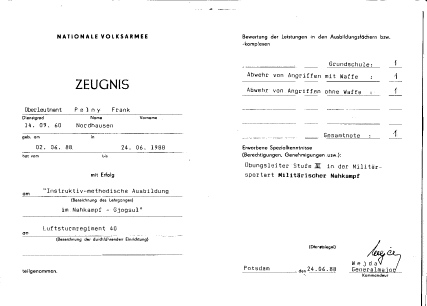
Through the evaluation of these course experiences, the military close combat system of the NPA was modified with suitable elements of the war-tested GJOGSUL. The result was a highly effective close combat system, which spread throughout the military forces.

 The technical basics of the GJOGSUL were through Captain Frank Pelny, a course participant, described in text and graphically represented in the "Dokumentation about the methodical training in Gjogsul" Ag 117 XL 111-03056-89), detachment of the military forces of the NPA 1989.
The technical basics of the GJOGSUL were through Captain Frank Pelny, a course participant, described in text and graphically represented in the "Dokumentation about the methodical training in Gjogsul" Ag 117 XL 111-03056-89), detachment of the military forces of the NPA 1989.
A total representation of the military close combat system including gjogsul resulted in Frank Pelny's book, "Gjogsul - military close combat in the NPA", which was released in 2005 by Books on Demand GmbH Norderstedt / Germany (ISBN 3-8334-2228-9; 352 Pages; about 550 photos) the book is available at the SaCO office.
HISTORY OF GJOGSUL
The roots of Gjogsul stretch as far back as 420 before time. At the time, there was a fight system in old Korea called Subak. The simple people practiced Subak and it involved defence with all rustic weapons against the warriors of the sovereigns who suppressed and robbed the people.
Subak actually means melon. To demonstrate one's capacity, it was necessary as a test to break open melons. Depending on the size and strength, the melons had to be cleanly cut into pieces with one blow from the edge of the hand. It was after this tradition that this style of fighting was called Subak.
In another version, people say that the aim was to strike the opponent to the floor with a stone-hard blow of the edge of the hand. This fight often had a deadly end.
With this depiction, it was clear to the experts of the East Asian martial arts that the roots of the Gjogsul were similar to the origins of the Taekwondo. That is the reality of it. Until the beginning of the 20th Century, there was still no defined difference in development between Taekyon and Gjogsul. It was not until the colonial rule of the Japanese in Korea in this century that there was a separation in the developments. The reason for this was simply that the people needed a fighting system against the Japanese with which they could be fully armed to fight their victorious enemies who were equipped with modern weapons. The almost unarmed people in most cases had to first disarm the enemy so that they too could have a chance. Many new techniques emerged, above all defence techniques against armed opponents like the attack techniques with these weapons.
1926 was officially made the year of origin of the Gjogsul. At this point in time, the leader of the Korean Resistance Fighters, Kim II Sung, trained in these special close combat techniques with his loyals so that they could successfully fight against the Japanese.
Most important in Gjogsul is that all positions, movements and fighting techniques prove their effectiveness in practical close combat and cause further development through practice.
Further essential impulses maintained the Gjogsul through the war in Korea from 1950 to 1953, in which the close combat techniques proved their effectiveness also against the physically superior American soldiers.
Based on the tense political and military situation at the border between North and South Korea, the development of the Gjogsul is until today at a standstill. There is for example a system in Gjogsul for the duel in and under water, which basically consists of hand techniques.
Today, the Gjogsul represents an essential training element in the military forces of the Korean People's Army. Every member of the army receives a Gjogsul training during his defence service. For the specialists, at least 300 to 400 hours Gjogsul training in a year is common.
Gjogsul is organised in eight training levels, four school degrees and four master degrees.
Through this narrow collaboration of the East European former communist countries with the Korean People's Republic, it was possible in around 1980 for the Korean Gjogsul masters to introduce their close combat system in some East European armies. There was secured knowledge on a special unit in the Polish Republic and on the paratrooper and special units of the military forces of the former GDR.

| Dschu dsche From personal strength (North Korean ideology by Kim Il Sung) |
Gjog Punching Play-offs Striking Attacking |
Sul Style Technique Fighting with consideration |
art of attacking create from own strength |
||
Gjogsul as a Contest
Gjogsul, as a realistic duel system, needs the permanent practical use and skill examination. A contest system was for this purpose developed which is, in the described form, today still carried out in the military forces of the Korean People's Republic. An independent contest system was built through its limited development in the National People's Army (NPA) of the former GDR. The Gjogsul contest is a full contact fight without weapons but with essential security equipment. The aim of the fight is for the opponent to mount the decisive hits as soon as possible. It's for this reason that with full contact and power, the attention and life of the partner are struck. The fight itself is from its course comparable to Box or Thai-box-fights. There are therefore frequently injuries.
Weight classes:
50, 55, 60, 65, 70, 75, 80 kg, +80 kg. all categories.
Fight Area:
- Similar to a boxing ring, area of 8 x 8 meters
- Height of the ring exhaustion 1,4 meters through a total of 4 ropes, one over the other.
- 0,5 meter security area around the ring, contestants in the red or blue
Fight Time:
After establishment 3 x 3, 4 x 3, 2 x 5 or 3 x 4 minutes. There is a one-minute break between the respective rounds.
Fight Outfits:
- Gjogsul suit (karate suit) or
- Short sport outfits (like the Thai boxing)
Security Equipment:
- Head protection
- Mouth protection
- Special gloves
- Elbow protection
- Depth protection
- Fighting is done bare-footed
Fight Court:
- Main referee:
responsible for the regular progress of the fight, controls the work of the referee and the side referee, double checks the list of participants, runs the contest list and defines the corners for the fighters. - Referee:
leads the fight in the fight area. - 3 - 5 side referees per fight area:
value the course of the fight and register it in the contest protocol. - Time keepers:
responsible for time keeping during the fight, announce the beginning of the fight three seconds before with a loud bang and the actual beginning with a gong or a bell, breaks and the end of a fight are announced with a gong and the end of the breaks after 45 seconds with a loud knock.
Fight Rules:
- All techniques in free form, individually or as a combination, are allowed.
- After a shock or a fall to the ground of a fighter, the attacker is allowed up to three seconds to strike back in order to bring on a technique. After three seconds, the fight will be broken up and up to 8 seconds for the one on the ground to get up.
- If a fighter falls to the ground three times or has three warnings within one round, he has lost the fight.
- The fight goes on until the end. In obvious defeat, the trainer can wave the towel to indicate the defeat of his fighter.
Punishment and Forbidden Actions:
Warnings:
-
- False blows (finger stings, scratching, techniques in the genitals)
- Repeated striking after the stop command
- Screaming and talking
- Inactivity.
Disqualification:
- Attack with full effect on someone lying on the ground after more than three seconds
- Having more than three warnings
- Unsportly behaviour or intentional injury of the opponent.
Estimations:
1/3 Point
-
- 1 effective blow
- 1 throw
1 Point
-
- Three times 1/3 Points
- K.O Blow
- Lever that led to the breaking of an arm or a leg.
1 Point deduction
- 1 warning
If an injured fighter has to leave, he has lost.
SaCO – What is this?
SaCO – What is this?
SELF-DEFENSE and CLOSE COMBAT ORGANIZATION
SaCO is a unique synthesis of:
- Self-defense
- for every man and woman
- regardless of the age or gender
- realistic, systematic
- use of aid
- observation of constitutional principles
- Police techniques
- for the police and security services
- Close combat technique / GJOGSUL
- for military experts
- uncompromising close combat techniques of the military special units from the former GDR
- revised close combat fight techniques from the North Korean GJOGSUL
- Fundamental fitness
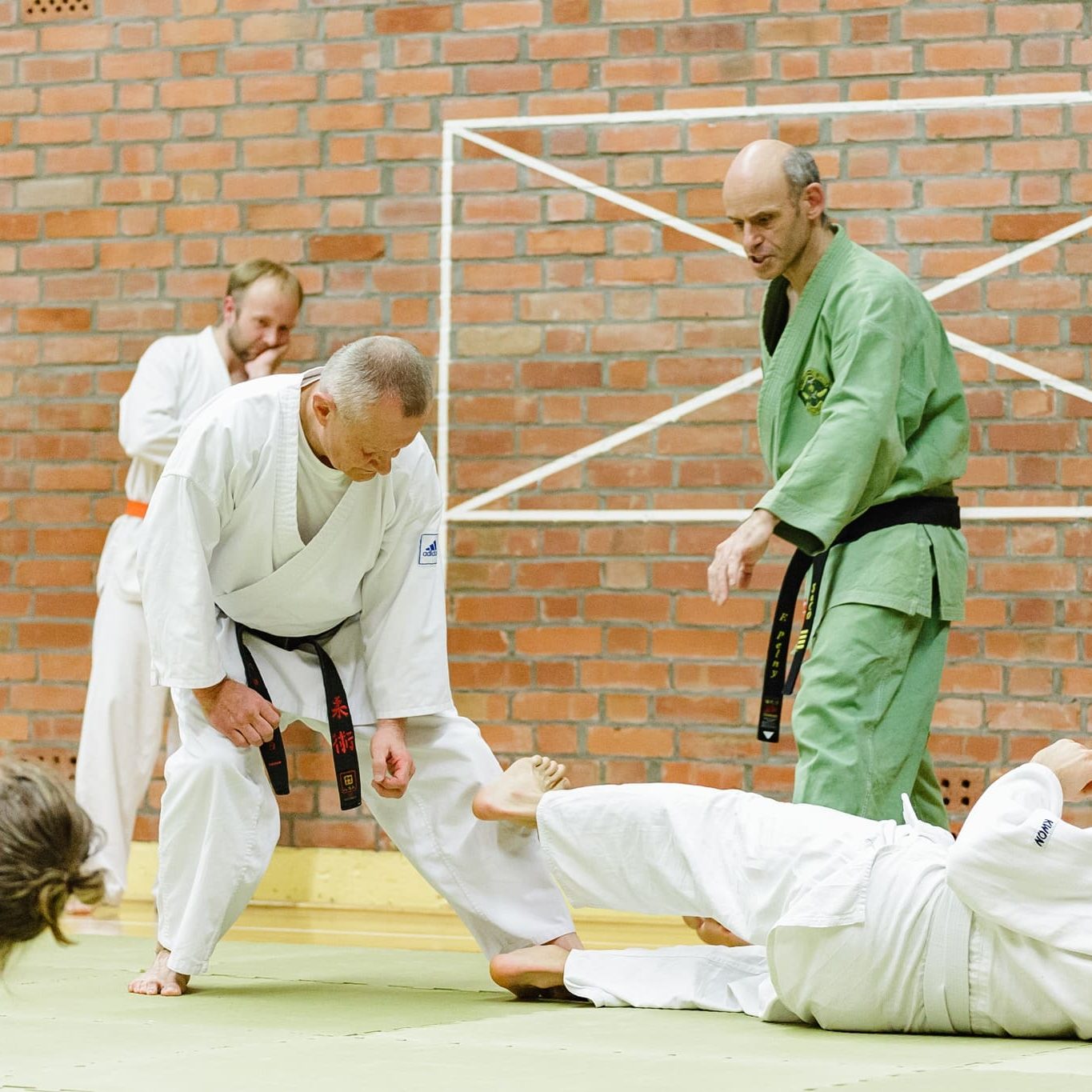

The rising rate of criminality and brutality today calls for higher security measures among citizens. The protection of our health and property has therefore become an important part of life.
SaCO teaches simple systematic methods of self-defense with which anyone can, in a dangerous situation, defend himself / herself regardless of their age or gender. Men and women from all age groups can learn from SaCO.

In addition, SaCO in every way, meets the requirements of all citizens rights in view of self-defense. SaCO offers several effective solutions for emergency situations.
At the same time, the instructors, police and military experts convey the uncompromising military close combat fighting techniques of the former GDR, which they through talent can effectively fulfil their specific assignments.

The basic techniques in SaCO are selected punches, blows and kicks. To supplement, some levers and throws, dealing with weapons (e.g. Tonfas and knives) and objects (e.g. sticks and belts) were taught for self-defense. Also offered were theoretical knowledge like legal foundations, vulnerable body parts and fair behaviour.
Important characteristics of the SaCO system
- All SaCO defences are simple and reliable actions, which were put together to form a systematic workable self-defense system.
The number of the governing techniques was restricted to a minimum and their application systematised. - The handling of different weapons and objects in duel was simultaneously taught with unarmed defence techniques.
Through this, it acquired revised principle knowledge and skills in dealing e.g. with sticks, tonfas, knives e.t.c. These can be effectively used for defence in extreme cases of emergency. - The modern SaCO self-defense is standardised in form of teaching and testing programmes.
Knowledge and skills in the area of duel are offered and this enables everyone to improve their individual skills regardless of if it's a housewife, wrestler or a security expert. - The military close combat techniques are tested, uncompromising and effective.
The military close combat techniques originated from the military close combat of the military experts in the former GDR. Strong influence comes from the Korean GJOGSUL close combat system, through which the North Koreans have for many years with high effectiveness practically used.
